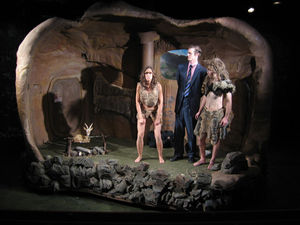Art Object, Text, & Media
Text: Pastoralia and Brad Carrigan, American by George Saunders
Pastoralia is a satire about two people, a man and a woman, who work at a amusement park in a surreal world disturbingly similar to our own. The park does not offer rides, but instead features bits of human history as something that can be visited. Unlike a natural history museum, the humans are alive and play the role of the humans from another era. The case that Saunders focuses on is the man and woman playing the cave man. Visitors of the park come by to watch them pick fleas out of each others hair, smash rocks together, and cook the goat that is placed in the "Big Slot" at the end of every day by the authorities. They authorities who run the institution do not allow them to act like real human beings, and they are forced to stay in character constantly, while at the same time, filling our peer reviews on their partners performance. When reading, I feel pity for the cave men, and disgust for the visitors of the museum. What is more disturbing about the story, is that it is not so unlike some of the entertainment we have today. Pastoralia is not the only works by Saunders that describes a world disturbingly close to our own. Much of our entertainment today is dark, and has become more and more dehumanizing, and just as dystopian science fiction movies warn us of the potential domination our species may face, Saunders creates these parallel worlds which mimic a similar fear. I view Saunders' writing as a less terrifying brand of science fiction, but it is some how much sadder. There is a quite tragedy in the stories, because even the characters that can see the darkness of the world they are in, Saunders' places them in a world where they have no one to share their fear with. For example, in "Brad Carrigan, American", Brad witnesses his own wife and her disturbing side kick, Chief Wayne, watching FinalTwist, a reality TV show in which sick pranks are played on people:
" Doris, come on," says Brad. "These are real people, people with thoughts and hopes and dreams."
"Well, nobody got hurt," says Chief Wayne.
"Except those kids who unknowingly ate their own mothers," says Brad.
"Well, they signed the releases," says Chief Wayne.
On Saunders: "He has been giving us ever more interesting and distinctive glimpses of a surreal world that is not quite our own, but frighteningly close. Saunders creates a world of people who regret their lives but still manage to find optimism, a world where free market economic principals dominate every aspect of life, and a world where everyones languages is suffused with corporate doublespeak and self help homilies"
Object: Natural History, Damien Hirst
Hirst's Natural History project consists of numerous dead animals preserved in class tanks in a museum so that he can discuss his curiosity into his own death. I find this entire project cold, and not at all about death, but the inflation of his own life over all these others. The fact that he finds the dead bodies of these creatures more interesting than the lives that any of those species have, reminds me of the entertainment created by the institution in Pastorialia, and the fiction TV show "Final Twist" . Just as those former human histories are intended to appeal to human curiosity of the past, these dead animals are some how intended to comfort Hirst in the thoughts of his own death.
The animals have "the illusion of life", just like the characters in pastoralia. They are putting on the illusion of life, but must completely suppress the lives that they actually are living for the benefit of the viewer. Just like the makers of "Final Twist", Hirst is only trying to sell something. I just can not sympathize with interest in death, and I find it hard to imagine that anyone could find the presence of a bunch of large, dead animals comforting. I feel like Brad, pointing out that those college kids have just eaten their parents, but because the pieces have an asthetic beauty, the disturbing man behind the works are overlooked.
Film: Thx 1138, and or Equilibrium Both of these films are dystopian films with essentially the same plot. Both are focuses on a character who is well behaved, and follows the rules of the repressive dystopian society. They are both forced to consume emotion killing drugs so that they can better function as a utility for the new world. I think that the sentiment of pastoralia, and my judgment of Hirst, are both a preview of the kind of loss of emotion and sentiment that is enforced in these kind of stories. If people can so coldly institutionalize people and animals for their own curiosity, it is not that far of a reach to imagine a government that would institutionalize all of us for a new type of world, focused on utility and structure, and free from all emotions. Films like these, and stories like Saunders are an example of a concern that humans we eventually detach from our emotions for the priority of utility, or entertainment.
why did i chose these? what is the link between my interests, and these obejcts?

